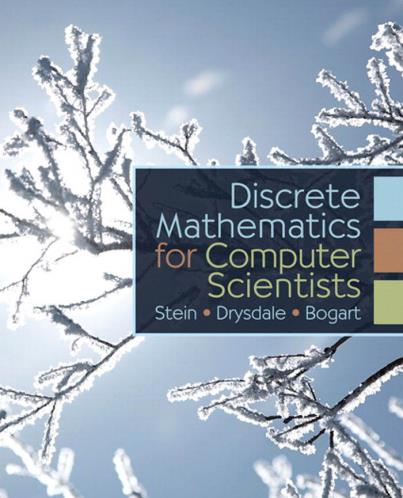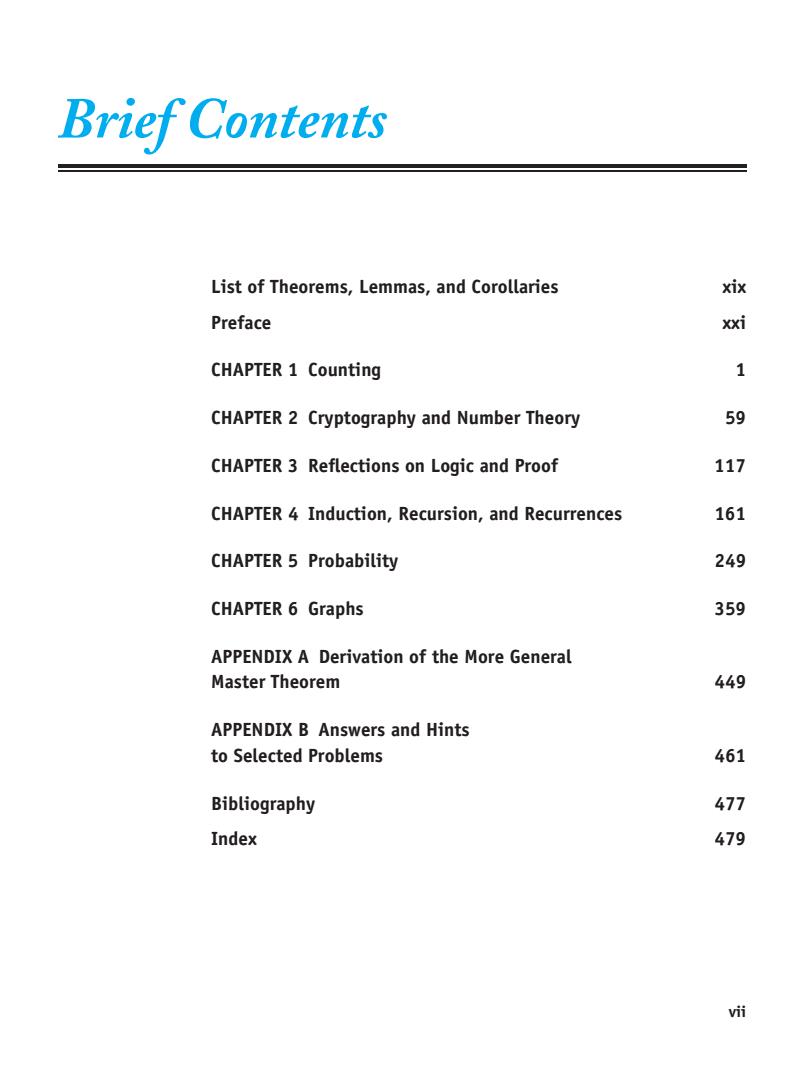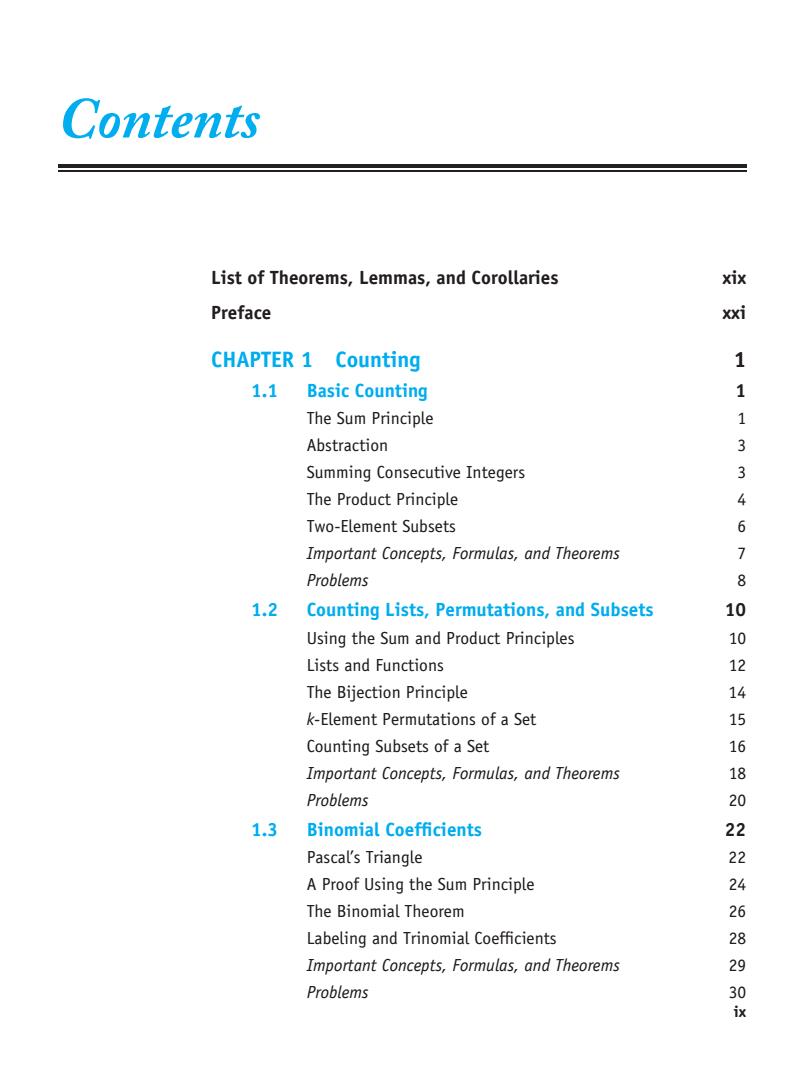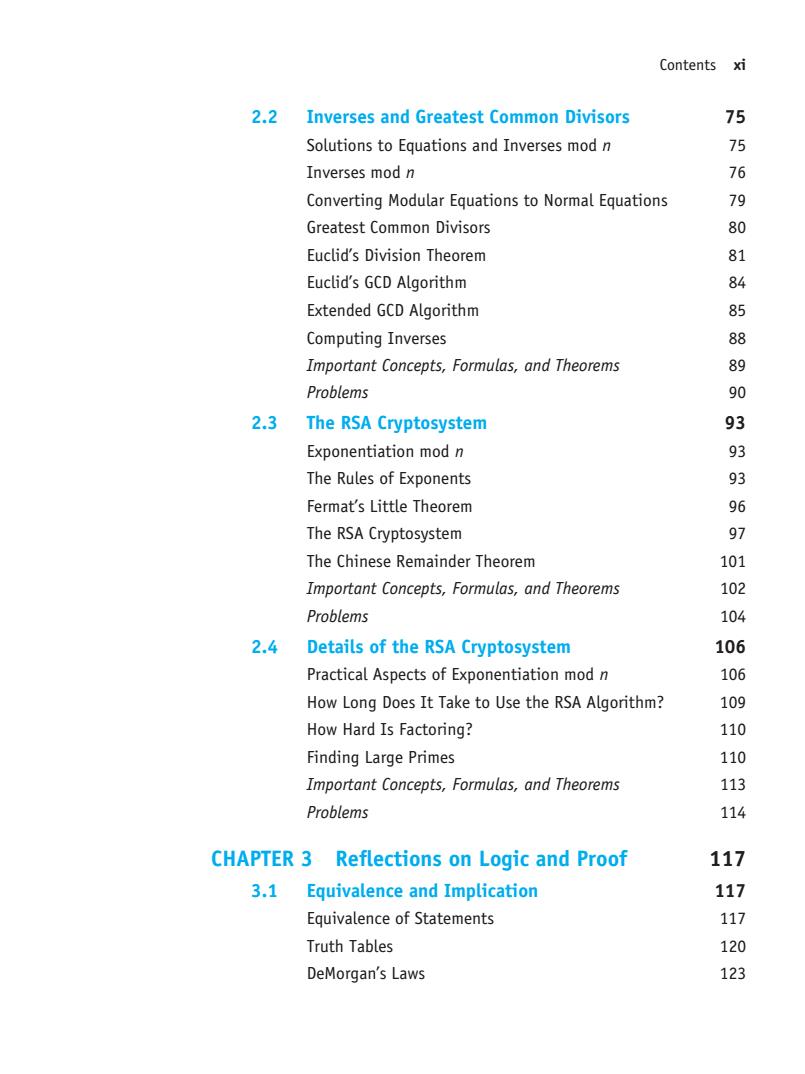
Discrete Mathematics for Computer Scientists Stein·Drysdale·Bogart

Brief Contents List of Theorems,Lemmas,and Corollaries xix Preface xxi CHAPTER 1 Counting 1 CHAPTER 2 Cryptography and Number Theory 59 CHAPTER 3 Reflections on Logic and Proof 117 CHAPTER 4 Induction,Recursion,and Recurrences 161 CHAPTER 5 Probability 249 CHAPTER 6 Graphs 359 APPENDIX A Derivation of the More General Master Theorem 449 APPENDIX B Answers and Hints to Selected Problems 461 Bibliography 477 Index 479 vii
Brief Contents List of Theorems, Lemmas, and Corollaries xix Preface xxi CHAPTER 1 Counting 1 CHAPTER 2 Cryptography and Number Theory 59 CHAPTER 3 Reflections on Logic and Proof 117 CHAPTER 4 Induction, Recursion, and Recurrences 161 CHAPTER 5 Probability 249 CHAPTER 6 Graphs 359 APPENDIX A Derivation of the More General Master Theorem 449 APPENDIX B Answers and Hints to Selected Problems 461 Bibliography 477 Index 479 vii

Contents List of Theorems,Lemmas,and Corollaries xix Preface xxi CHAPTER 1 Counting 1 1.1 Basic Counting 1 The Sum Principle 1 Abstraction 3 Summing Consecutive Integers 3 The Product Principle 4 Two-Element Subsets 6 Important Concepts,Formulas,and Theorems 7 Problems 8 1.2 Counting Lists,Permutations,and Subsets 10 Using the Sum and Product Principles 10 Lists and Functions 12 The Bijection Principle 14 k-Element Permutations of a Set 15 Counting Subsets of a Set 16 Important Concepts,Formulas,and Theorems 18 Problems 20 1.3 Binomial Coefficients 22 Pascal's Triangle 22 A Proof Using the Sum Principle 24 The Binomial Theorem 26 Labeling and Trinomial Coefficients 28 Important Concepts,Formulas,and Theorems 29 Problems 30 ix
Contents List of Theorems, Lemmas, and Corollaries xix Preface xxi CHAPTER 1 Counting 1 1.1 Basic Counting 1 The Sum Principle 1 Abstraction 3 Summing Consecutive Integers 3 The Product Principle 4 Two-Element Subsets 6 Important Concepts, Formulas, and Theorems 7 Problems 8 1.2 Counting Lists, Permutations, and Subsets 10 Using the Sum and Product Principles 10 Lists and Functions 12 The Bijection Principle 14 k-Element Permutations of a Set 15 Counting Subsets of a Set 16 Important Concepts, Formulas, and Theorems 18 Problems 20 1.3 Binomial Coefficients 22 Pascal’s Triangle 22 A Proof Using the Sum Principle 24 The Binomial Theorem 26 Labeling and Trinomial Coefficients 28 Important Concepts, Formulas, and Theorems 29 Problems 30 ix

x Contents 1.4 Relations 32 What Is a Relation? 32 Functions as Relations 33 Properties of Relations 33 Equivalence Relations 36 Partial and Total Orders 39 Important Concepts,Formulas,and Theorems 41 Problems 42 1.5 Using Equivalence Relations in Counting 43 The Symmetry Principle 43 Equivalence Relations 45 The Quotient Principle 46 Equivalence Class Counting 46 Multisets 48 The Bookcase Arrangement Problem 50 The Number of k-Element Multisets of an n-Element Set 51 Using the Quotient Principle to Explain a Quotient 52 Important Concepts,Formulas,and Theorems 53 Problems 54 CHAPTER 2 Cryptography and Number Theory 59 2.1 Cryptography and Modular Arithmetic 59 Introduction to Cryptography 59 Private-Key Cryptography 60 Public-Key Cryptosystems 63 Arithmetic Modulo n 65 Cryptography Using Addition mod n 68 Cryptography Using Multiplication mod n 69 Important Concepts,Formulas,and Theorems 71 Problems 72
x Contents 1.4 Relations 32 What Is a Relation? 32 Functions as Relations 33 Properties of Relations 33 Equivalence Relations 36 Partial and Total Orders 39 Important Concepts, Formulas, and Theorems 41 Problems 42 1.5 Using Equivalence Relations in Counting 43 The Symmetry Principle 43 Equivalence Relations 45 The Quotient Principle 46 Equivalence Class Counting 46 Multisets 48 The Bookcase Arrangement Problem 50 The Number of k-Element Multisets of an n-Element Set 51 Using the Quotient Principle to Explain a Quotient 52 Important Concepts, Formulas, and Theorems 53 Problems 54 CHAPTER 2 Cryptography and Number Theory 59 2.1 Cryptography and Modular Arithmetic 59 Introduction to Cryptography 59 Private-Key Cryptography 60 Public-Key Cryptosystems 63 Arithmetic Modulo n 65 Cryptography Using Addition mod n 68 Cryptography Using Multiplication mod n 69 Important Concepts, Formulas, and Theorems 71 Problems 72

Contents xi 2.2 Inverses and Greatest Common Divisors 75 Solutions to Equations and Inverses mod n 75 Inverses mod n 76 Converting Modular Equations to Normal Equations 79 Greatest Common Divisors 80 Euclid's Division Theorem 81 Euclid's GCD Algorithm 84 Extended GCD Algorithm 85 Computing Inverses 88 Important Concepts,Formulas,and Theorems 89 Problems 90 2.3 The RSA Cryptosystem 93 Exponentiation mod n 93 The Rules of Exponents 93 Fermat's Little Theorem 96 The RSA Cryptosystem 97 The Chinese Remainder Theorem 101 Important Concepts,Formulas,and Theorems 102 Problems 104 2.4 Details of the RSA Cryptosystem 106 Practical Aspects of Exponentiation mod n 106 How Long Does It Take to Use the RSA Algorithm? 109 How Hard Is Factoring? 110 Finding Large Primes 110 Important Concepts,Formulas,and Theorems 113 Problems 114 CHAPTER 3 Reflections on Logic and Proof 117 3.1 Equivalence and Implication 117 Equivalence of Statements 117 Truth Tables 120 DeMorgan's Laws 123
Contents xi 2.2 Inverses and Greatest Common Divisors 75 Solutions to Equations and Inverses mod n 75 Inverses mod n 76 Converting Modular Equations to Normal Equations 79 Greatest Common Divisors 80 Euclid’s Division Theorem 81 Euclid’s GCD Algorithm 84 Extended GCD Algorithm 85 Computing Inverses 88 Important Concepts, Formulas, and Theorems 89 Problems 90 2.3 The RSA Cryptosystem 93 Exponentiation mod n 93 The Rules of Exponents 93 Fermat’s Little Theorem 96 The RSA Cryptosystem 97 The Chinese Remainder Theorem 101 Important Concepts, Formulas, and Theorems 102 Problems 104 2.4 Details of the RSA Cryptosystem 106 Practical Aspects of Exponentiation mod n 106 How Long Does It Take to Use the RSA Algorithm? 109 How Hard Is Factoring? 110 Finding Large Primes 110 Important Concepts, Formulas, and Theorems 113 Problems 114 CHAPTER 3 Reflections on Logic and Proof 117 3.1 Equivalence and Implication 117 Equivalence of Statements 117 Truth Tables 120 DeMorgan’s Laws 123